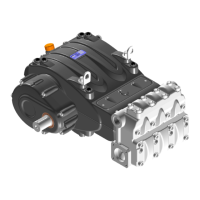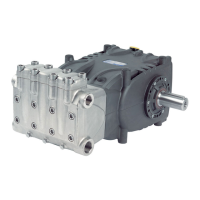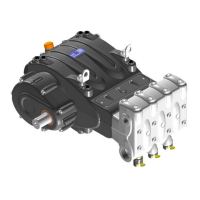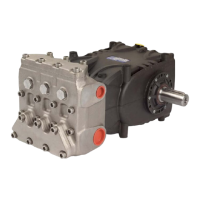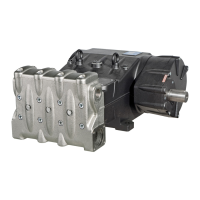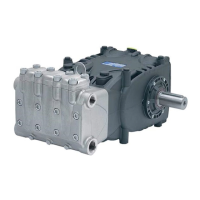Do you have a question about the Pratissoli INTERPUMP KT Series and is the answer not in the manual?
Details various warning and danger symbols used in the manual, including specific ATEX explosion protection marking.
Details essential safety measures for high pressure systems, including safety valves, component protection, and pipe integrity.
Covers safe work area marking, authorized personnel instruction, and pre-operation checks for system safety.
Emphasizes operator safety, PPE, team coordination, and safe handling practices when using lances with water jets.
Explains how to identify the pump model and serial number using the identification plate and its details.
Outlines safety protocols for maintenance, emphasizing trained personnel, correct assembly, and use of original spare parts.
Provides detailed dimensions and weight for different pump versions, illustrated with diagrams for installation planning.
Specifies maximum permissible water temperature and rated maximum pressure and flow rate for pump operation.
Defines minimum pump speed, covers sound emission detection, and details vibration measurement procedures.
Lists recommended oils for corrosion resistance and fatigue, plus guidelines for oil level checks and changes.
Describes the pump's inlet and outlet ports, specifying sizes (1 1/4 Gas and 1 Gas) and connection requirements.
Provides instructions for checking pump oil level and performing oil changes, including viscosity guidelines based on temperature.
Details horizontal pump fixing, torque specifications, vibration damping, and essential earthing for safety.
Explains how to identify rotation direction and outlines the procedure for changing the pump version by trained personnel.
Provides guidelines for hydraulic connections, emphasizing flexible piping, suction hose rigidity, and preventing cavitation.
Details suction line requirements for smooth operation and mandates filter installation on the suction line for pump protection.
Covers outlet line design, including fluid velocity, flexible hoses, high-pressure fittings, and pressure relief valves.
Provides a graph to determine the internal diameter of suction and outlet ducts based on flow rate and velocity.
Recommends V-belt types and specifies pulley diameter, radial load, and distance for proper transmission setup.
Diagram illustrating power transmission capacity per V-belt type based on pulley speed and belt count.
Provides detailed specifications for V-belt sections, grooving, tolerances, and pulley calculations for system integration.
Advises using high-performance belts like XPB for potential benefits in belt quantity and overall system length.
Explains factors influencing static pull and provides a diagram to determine belt bend for wheelbase and load.
Describes power transmission options from an auxiliary PTO using V-belts or joints, including torque specifications.
Lists essential pre-start-up checks, including suction line integrity, valve positions, and tightening of connections for safe operation.
Details the step-by-step procedure for starting the pump, including checks for rotation, pressure, and running without load.
Provides guidance on checking pump function after prolonged inactivity and method for filling with anti-corrosion or anti-freeze solution.
Outlines the preventive maintenance schedule based on operating hours, including oil checks, valve, and seal replacements.
Advises against running the pump in icy conditions and recommends following frost protection measures.
Details the warranty period, conditions, and circumstances under which the guarantee will be invalidated.
Lists causes for pump not priming or pulsating irregularly, such as air suction, insufficient supply, or valve issues.
Covers causes for low flow, excessive noise, overheating, insufficient pressure, or vibrations.
Detailed exploded view of the KT LP pump showing component numbers and a comprehensive list of parts with codes.
Categorizes spare parts into kits (A-E) for different pump models, listing kit codes and applicable pump series.
Detailed list of parts for KT36B, KT40B, W120120, and W100140 pumps, including part numbers and quantities.
Illustrates the flushing circuit diagram with recommended flow rate and fluid pressure for proper system operation.
Official declaration by the manufacturer stating compliance with EU directives and standards for the pump model.
| Model | KT Series |
|---|---|
| Category | Water Pump |
| Manufacturer | Pratissoli INTERPUMP |
| Plunger Material | Ceramic |
| Power Source | Electric |
| Maximum Head | Varies by model |
| Inlet Diameter | Varies by model, consult specific datasheet |
| Outlet Diameter | Varies by model, consult specific datasheet |
| Inlet Port Size | Varies by model, consult specific datasheet |
| Outlet Port Size | Varies by model, consult specific datasheet |
| Motor Power | Varies by model, consult specific datasheet |
| Voltage | Varies by model |
| Frequency | Varies by model |
| Pump Material | Stainless Steel |
| Material | Stainless Steel |
| Weight | Varies by model, consult specific datasheet |
